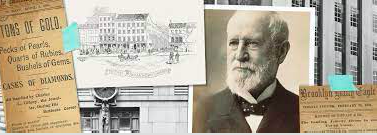Nothing Very Bad (1837)
Pandora’s Box unleased all the evils into the world, but a robin egg-colored blue box holds treasures of exquisite craftmanship. Although Tiffany’s is an icon, its founder remains a shadowy presence.
Long before Marilyn Monroe mentioned Tiffany’s in her signature song “Diamonds Are a Girl’s Best Friend,” there was Charles Lewis, born in 1812, in Killingly, Connecticut, to Chloe and Comfort Tiffany. At age twenty-five, Charles borrowed a $1,000 from his father, and along with his friend, John B. Young, opened a stationery and fancy goods store in New York City. He married his partner’s sister, Harriet Olivia Young, with whom he had six children.
Discouraged at only earning $4.98 in its first three days, the men expanded their merchandise to include Chinese porcelains and French accessories purchased directly from ships returning from foreign ports. With the fall of King Louis Phillippe, Charles acquired one-third of the French Crown Jewels in an auction at the Louvre that led the press to dub him “The King of Diamonds.” In 1845, the company published America’s first mail-order catalogue. With the advent of the California Gold Rush, the store added the gleaming metal to their repertoire.
Another coup occurred in 1858 with the laying of the Atlantic telegraph cable. Charles bought twenty miles of unused cable and cut it into four-inch length sections, embellished with brass. He fashioned other parts into umbrella handles, paperweights, and charms. Crowds, coveting a slice of history, were so huge that the police had to restrain frenzied shoppers. He also partnered with P. T. Barnum and created a jeweled carriage as a wedding gift for Tom Thumb. Charles moved his busines to Fifth Avenue in Manhattan that included a huge stature of Atlas beneath a clock. Tiffany gained the presidential seal of approval when President Roosevelt wore the brand’s watch at the historic Yalta conference.
The crown jewel of the emporium arrived when Charles purchased the world’s largest yellow diamond from the Kimberley mine in South Africa. The Tiffany Diamond-on permanent display in the Manhattan store-eventually graced the necks of Audrey Hepburn, Lady Gaga, and Beyonce. Tiffany & Co became the imperial jeweler of clients such as the czar and the Shah of Iran. Gilded Age greats such as the Vanderbilts, the Asters, the Whitneys also paid homage. A rite of passage is for prospective grooms to propose with a sparkler encased in a blue box. While the gesture does not guarantee a yes, it makes it a helluva a lot harder to say no.
Upon his death, Charles left an estate-in contemporary currency-of $1 billion, and a lasting legacy. In 1885, Tiffany redesigned the Great Seal of the United States whose design still graces the back of paper currency. The store lent its name to a James Bond girl, as well as President Trump’s daughter. Melania gifted Michelle with a silver picture frame, encased in the blue box. Veering into the arena of sports, Tiffany’s designed the Vince Lombardi Super Bowl trophy, the silver cup for the United Sates Open Tennis championships, and the Belmont Stakes cup. The brand also designed the interlocking “NY” loco for the New York Yankees.
Tiffany’s also entered the world of fiction when Sex and the City character Trey presented Charlotte with a stunning solitaire from New York City’s finest jewelry store. However, what seared the brand into the pop culture was the 1961 film, starring Audrey Hepburn as Holly Golightly. The iconic scene shows the actress, staring longing into the store window, uttering that when she is feeling bad, “The only thing that does any good is to jump in a cab and go to Tiffany’s. Nothing very bad could happen to you there.”


